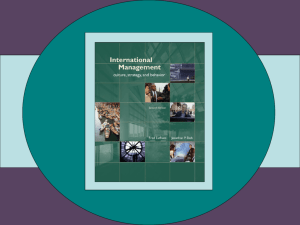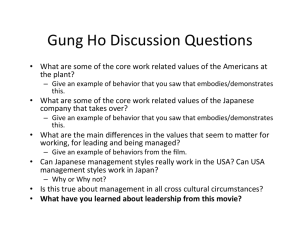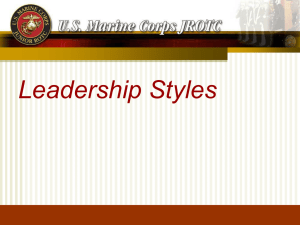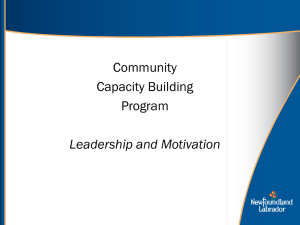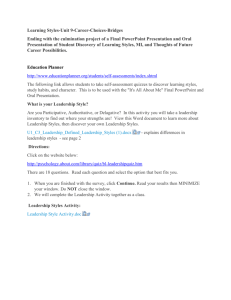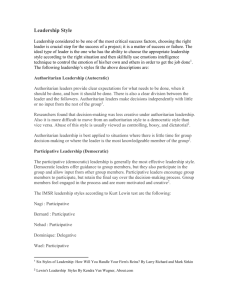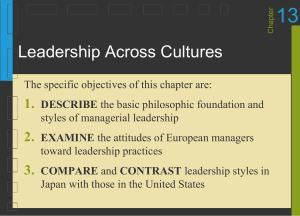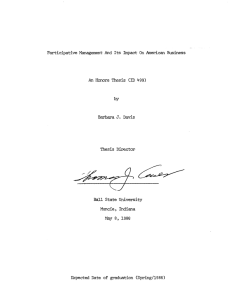International Leadership
advertisement
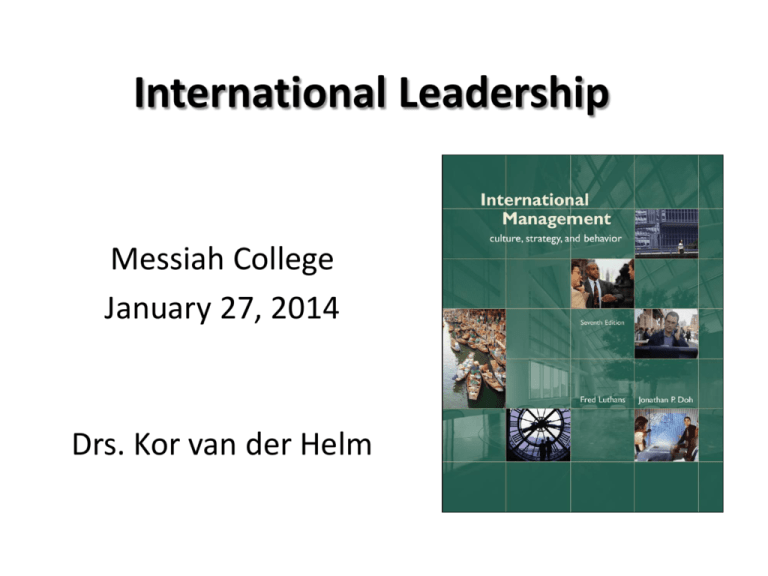
International Leadership Messiah College January 27, 2014 Drs. Kor van der Helm specific objectives The specific objectives are: 1. DESCRIBE the basic philosophic foundation and styles of managerial leadership 2. EXAMINE the attitudes of European managers toward leadership practices 3. COMPARE and CONTRAST leadership styles in Japan with those in the United States specific objectives (continued): 4. REVIEW leadership approaches in China, the Middle East, and developing countries. 5. EXAMINE recent research and findings regarding leadership across cultures. 6. DISCUSS the relationship of culture clusters and leader behavior to effective leadership practices, including increasing calls for more responsible global leadership. perceived differences in leadership leadership theories • Theories X, Y and Z (philosophical background): – Theory X: A manager who believes that people are basically lazy and that coercion and threats of punishment often are necessary to get them to work. – Theory Y: A manager who believes that under the right conditions people not only will work hard but will seek increased responsibility and challenge. – Theory Z: A manager who believes that workers seek opportunities to participate in management and are motivated by teamwork and responsibility sharing. managerial beliefs about work in Russia leadership behaviors and styles • Leadership Behaviors and Styles: – Authoritarian: use of work-centered behavior designed to ensure task accomplishment. – Paternalistic: use of work-centered behavior coupled with protective employee centered concern – Participative: use of both work or task centered and people centered approaches to leading subordinates. leader-subordinate interactions leader-subordinate interactions leadersubordinate interactions leadership in the international context • how leaders in other countries attempt to direct or influence their subordinates. • international approaches to leadership • research shows there are both similarities and differences. Most international research has focused upon Europe, East Asia, the Middle East, and developing countries such as India, Peru, Chile, and Argentina. leadership in the international context European managers tend to use a participative approach. Researchers investigated four areas relevant to leadership: 1. capacity for leadership and initiative (Theory X vs. Theory Y) 2. sharing information and objectives: general vs. detailed, completed instructions for subordinates. 3. participation: leadership support for participative leadership 4. internal control: leader control through external vs. internal means country clusters leadership in the international context • the role of level, size, and age on European managers’ attitudes toward leadership: – higher level managers tend to express more democratic values than lower-level managers in some countries; in other countries the opposite is true. – company size tends to influence the degree of participative-autocratic attitudes – younger managers were more likely to have democratic values in leadership and initiative, information sharing and objectives leadership in the international context • European leadership practices - conclusion – most European managers tend to reflect more participative and democratic attitudes – organizational level, company size, and age greatly influence attitudes toward leadership – many young people from the study of the 1960s and 1970s are now middle-aged-European managers, who are highly likely to be more participative than their younger counterparts from the study of 1980s and 1990s leadership in the international context: Japanese • Japan is well known for its paternalistic approach to leadership • Japanese culture promotes a high safety or security need, which is present among home country-based employees as well as Multi National Corp. expatriates • Japanese managers have much greater belief in the capacity of subordinates for leadership and initiative than do managers in most other countries. Only managers in Anglo-American countries had stronger feelings in this area international leadership: Japanese vs. American • except for internal control, large U.S. firms tend to be more democratic than small ones; profile is quite different in Japan. • younger U.S. managers express more democratic attitudes than their older counterparts on all four leadership dimensions • Japanese and U.S. managers have different philosophies of managing people. Ouchi’s Theory Z combines Japanese and U.S. assumptions and approaches. international leadership: Japanese vs. American • how senior managers process information and learn: – variety amplification: U.S. executives are taught and tend to use variety amplification-the creation of uncertainty and the analysis of many alternatives regarding future action. – variety reduction: Japanese executives tend to use variety reduction—limiting uncertainty and focusing action on a limited number of alternatives. leadership in China • the “New Generation” group scored significantly higher on individualism than did the current and older generation groups • they also scored significantly lower than the other two groups on collectivism and Confucianism • these values appear to reflect the period of relative openness and freedom, often called the “Social Reform Era,” in which these new managers grew up • they have had greater exposure to Western societal influences may result in leadership styles similar to those of Western managers leadership in the Middle-East • there may be much greater similarity between Middle Eastern leadership styles and those of Western countries • western management practices are evident in the Arabian Gulf region due to close business ties between the West and this oilrich area as well as the increasing educational attainment, often in Western universities, of Middle Eastern managers • organizational culture, level of technology, level of education, and management responsibility were good predictors of decision-making styles in the United Arab Emirates • there is a tendency toward participative leadership styles among young Arab middle managers, as well as among highly educated managers of all ages leadership in other developing countries • managerial attitudes in India are similar to AngloAmericans toward capacity for leadership and initiative, participation, and internal control, but different in sharing information and objectives • leadership styles in Peru may be much closer to those in the United States than previously assumed • developing countries may be moving toward a more participative leadership style recent leadership findings: transformational-transactional-charismatic Transformational or servant leaders: • source of charisma; enjoy admiration of followers • idealized influence: enhance pride, loyalty, and confidence in their people; align followers by providing common purpose or vision that the latter willingly accept • inspirational motivation: extremely effective in articulating vision, mission, beliefs in clear-cut ways • intellectual stimulation: able to get followers to question old paradigms and accept new views of world • individualized consideration: able to diagnose and elevate needs of each follower in way that furthers each one’s development other types of leadership • four other types of leadership are less effective than transformational: – contingent reward: clarifies what needs to be done; provides psychic and material rewards to those who comply – active management-by-exception: monitors follower performance and takes corrective action when deviations from standards occur – passive management-by-exception: intervenes in situations only when standards are met – laissez-faire: avoids intervening or accepting responsibility for follower actions Middle Eastern vs. Western management qualities most demanded in European executives: culture clusters and leadership effectiveness Important attributes that form a concept of outstanding business leader – Anglo mangers identify performance orientation, an inspirational style, having a vision, being a team integrator, and being decisive as being the top five attributes – Nordic managers ranked these same five attributes as most important but not in same order – Rankings of clusters in the North/West European region were fairly similar – Substantial differences exist within and between the South/East European countries, countries from Eastern Europe, and Russia and Georgia rankings of leadership attributes recent findings • leader behavior, leader effectiveness, and leading teams: • one of the keys to successful global leadership is knowing what style and behavior works best in a given culture and adapting appropriately – in affective cultures, such as the United States, leaders tend to exhibit their emotions – in neutral cultures, such as Japan and China, leaders do not tend to show their emotions doing business in affective and neutral countries: leadership tips cross-cultural comparison positive organizational scholarship and leadership • Positive Organizational Scholarship (POS): Method that focuses on positive outcomes, processes, and attributes of organizations and their members. • Relates to leadership in that POS recognizes positive potential that people have within. • Effective leaders seem to live by POS as constantly innovate, create relationships, strive to bring organization to new heights, and work for greater global good through self improvement. • Consists of three sub-units: – Enablers: could be capabilities, processes or methods, and structure of the environment, which are all external factors. – Motivations: focus is inward (such as unselfish or altruistic). – Outcomes or effects: accentuate vitality, meaningfulness, highquality relationships. authentic leadership • Authentic leaders defined by an all encompassing package of traits, styles, behaviors, and credits. • 4 Distinct Characteristics: (1) do not fake actions; true to selves, do not adhere to external expectations; (2) driven from internal forces not external rewards; (3) unique and guide based on personal beliefs, not others’ orders; (4) act based on individual passion and values. • Authentic leadership similar to traditional leadership, but has higher awareness; authentic leadership can create a better understanding within the organization. cross-cultural leadership: six insights from the GLOBE study • Charismatic/Value Based: captures ability of leaders to inspire, motivate, encourage high performance outcomes from others based on foundation of core values • Team-oriented: emphasis on effective team building and implementation of common goal among team members • Participative: extent to which leaders involve others in decisions and decision implementation cross-cultural leadership: six insights from the GLOBE study • Humane-oriented: comprises supportive and considerate leadership • Autonomous: independent and individualistic leadership behaviors • Self-protective: ensures safety and security of individual and group through status enhancement and face-saving ethically responsible global leadership • linking leadership and corporate responsibility through responsible global leadership – Values Based Leadership – Ethical Decision Making – Quality Stakeholder Relationships Review and Discuss • What cultures would be the most likely to perceive differences between managerial and leadership duties? What cultures would view them as the same? Use evidence to support your answer. • Is there any relationship between company size and European managers’ attitude toward participative leadership styles? • What do U.S. managers need to know about leadership in the international arena? Identify and describe three important guidelines that can be of practical value.
